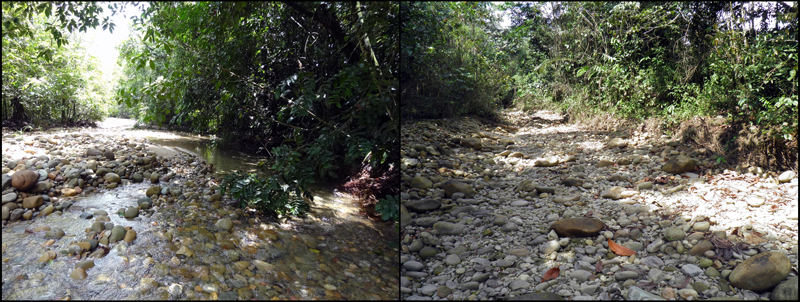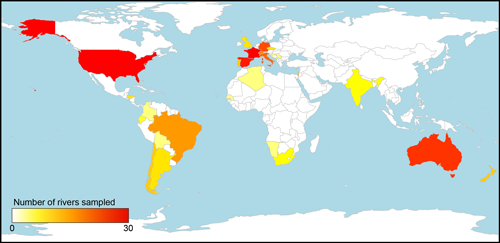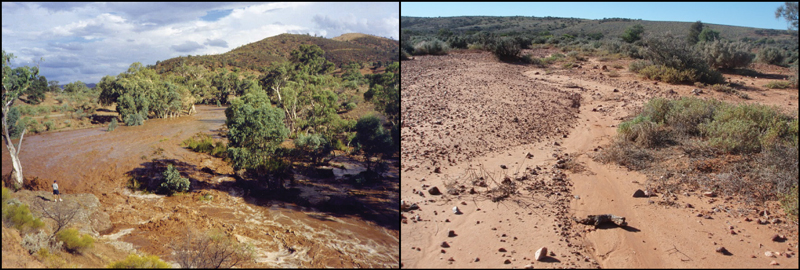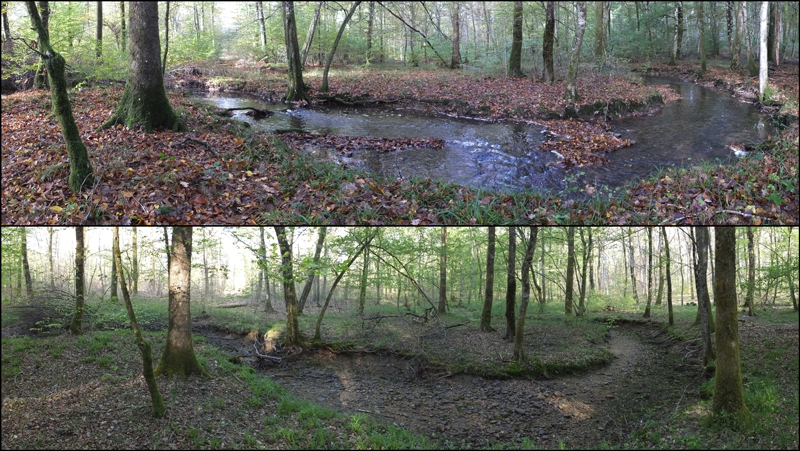More than half the length of the global river network consists of intermittent rivers and ephemeral streams (IRES), which by nature cease to flow or go completely dry at various times and places. More and more rivers and streams around the world, including some of the world’s largest rivers, are becoming intermittent as humans extract their water for drinking and irrigation and because of land-use alteration and climate change [Gleick, 2003; Datry et al., 2014].
Such drastic changes in flow regime and IRES distribution prompt fundamental questions: How are the biogeochemistry and biodiversity of river networks affected by these changes? How do these alterations vary across climatic and biogeographic regions? How can IRES be managed effectively to mitigate the ecological, social, and economic consequences of changing flow regimes?
To address these questions and follow up a call to action in the Policy Forum of Science [Acuña et al., 2014], a global and multidisciplinary approach is necessary. We have created a global science network, the 1000 Intermittent Rivers Project (#1000IRP on Twitter). The project’s main goal is to merge individual knowledge, forces, and passions through simple, consistent, and comparable joint experiments in IRES worldwide.
Plentiful IRES, Scant Knowledge
Despite the predominance of IRES, conceptual and empirical developments in river science have been derived exclusively from and for perennially flowing waters—rivers and streams that flow continuously from their source to a lake or ocean [Acuña et al., 2014; Datry et al., 2014]. As a result, incorporating IRES into existing models challenges some of the most persuasive paradigms in river science, including the role of river networks in global biogeochemical cycles, biodiversity, and ecosystem processes and services [Datry et al., 2014].
Intermittent rivers and ephemeral streams have been overlooked by scientists and water resources managers.
However, because IRES have been overlooked by scientists and water resources managers, their incorporation into river science has long been limited by the scarcity of data. For example, the total length and number of perennial river channels are relatively well quantified [Lehner et al., 2008; Raymond et al., 2013], but the spatial extent of IRES remains unexplored at a global scale.
This is especially troublesome because IRES are the predominant water bodies in water-scarce regions: For example, IRES account for 94% of the river network in Arizona, along with 66% of California’s streams and rivers [Levick et al., 2008]. IRES are also prevalent in humid regions, and they occur from Antarctica to Amazonia [McKnight et al., 1999; Benstead and Leigh, 2012; Raymond et al., 2013; Datry et al., 2014]. However, the global extent of river networks accounted for by IRES, their current and future distribution, their flow regimes, and their connections with perennial channels remain unknown.

We have scant knowledge about the consequences of alternating flowing, nonflowing, and dry phases to the cycling of materials along river networks and to associated biotic communities [Datry et al., 2014]. As a result, the ecological, economic, and social values of IRES, and their sensitivity to human activities, are poorly explored [Steward et al., 2012; Acuña et al., 2014; Datry et al., 2014].
Addressing the Data Shortage

Today 112 participants from 28 countries have joined the 1000IRP network (Figure 1), and more are expected to join in the near future. However, some global regions, including Africa and Asia, remain poorly represented in this collaborative effort. We encourage colleagues from countries in these regions to join the project.
The objectives of the 1000IRP are
- to raise awareness of the global prevalence and significance of IRES
- to improve the global estimate of the spatial and temporal extent of IRES and to describe their links with perennial rivers
- to conduct low-intensity field and laboratory experiments to address the key questions stated above
- to build an international network of researchers dedicated to IRES, to support, complement, and federate current and future international projects on IRES (e.g., Science and Management of Intermittent Rivers and Ephemeral Streams (SMIRES), Intermittent River Biodiversity Analysis and Synthesis (IRBAS), EU-LIFE Temporary Rivers (TRivers)), as well as global science network initiatives (e.g., Intergovernmental Science-Policy Platform on Biodiversity and Ecosystem Services (IPBES), Group on Earth Observations Biodiversity Observation Network (GEO BON), Future Earth)
Early Results
During its first year (2015–2016), 1000IRP challenged the current view of the role of river networks in the global carbon cycle.
During its first year (2015–2016), 1000IRP challenged the current view of the role of river networks in the global carbon cycle. Specifically, we aimed to determine the extent to which the integration of IRES affects the validity of current estimates of carbon transformation, transport, and deposition [Battin et al., 2008], including carbon dioxide (CO2) efflux rates [Raymond et al., 2013], from river networks.
IRES and perennial rivers have very distinctive biogeochemical functions and tempos [Foulquier et al., 2015]. Moreover, the dry phases of IRES can be biogeochemically active and may release substantial volumes of CO2 to the atmosphere [von Schiller et al., 2014]. During rewetting phases and first-pulse events (where water suddenly rewets a previously dry reach), large quantities of organic material, nutrients, and organisms that have accumulated along dry river sections can produce “hot moments” of biogeochemical transfer and transformation processes [Corti and Datry, 2012].

To determine the extent to which biogeochemical differences between IRES and perennial rivers affect current estimates of carbon fluxes in river networks, we require large-scale quantification of organic material accumulated along riverbeds during dry phases, as well as information on the biodegradability of this material and the reactivity of dry streambed sediments during rewetting events. We also require information about the potential environmental drivers controlling these processes, including climate, riparian cover (the plant life in and around rivers), substrate type, and duration and frequency of drying.
Each participant of 1000IRP has quantitatively sampled coarse organic matter accumulating along at least two dry river channels using standardized protocols. In addition, dry sediments and biofilms have been sampled at those sites and detailed information about climate, flow regime, substrate, and riparian zone conditions compiled. All samples, obtained from 210 river reaches, have now been received at the French National Research Institute of Science and Technology for Environment and Agriculture (IRSTEA) and further processed for laboratory analyses of the biodegradability and quality of the sampled material by the different leading institutions, including ash-free dry weight (University of Grenoble), carbon-to-nitrogen ratio (University of Grenoble), CO2 release (IRSTEA and University of the Basque Country), leaching (Leibniz Institute of Freshwater Ecology and Inland Fisheries (IGB)), and respiration of accumulated organic material and sediments (IRSTEA and University of the Basque).
We plan to analyze these data to refine current estimates of carbon transfer, deposition, and transformation, as well as CO2 efflux rates from river networks globally.
We plan to explore large-scale biodiversity patterns in IRES and describe biodiversity-ecosystem functional relationships within these unique ecosystems using metabarcoding, a DNA-based method that provides a rapid assessment of biodiversity. These studies will target microbes and aquatic and terrestrial biota and flora in riverbed sediments.
Widening the Network, Moving Ahead
This type of grassroots effort may serve as a model for global team science activities to close fundamental knowledge gaps.
Our objectives in writing this article are to promote 1000IRP to a wide, multidisciplinary audience; to strengthen the current network of contributors; and to encourage the inclusion of more participants and countries, especially from underrepresented areas (e.g., Africa, Asia, and Russia). This global science network can be considered a powerful example of joining forces in research to advance work on fundamental scientific questions [Baker, 2015].
Thanks to the success of this first year, we are planning additional joint experiments in the coming years to further advance our understanding of IRES and their overlooked geophysical, ecological, economic, and social signatures. Driving global research activities, networks, or team science from the bottom up will become more common in the future [Baker, 2015]. This type of grassroots effort may not only trigger subsequent research activities in IRES science but also serve as a model for global team science activities to close fundamental knowledge gaps.

References
Acuña, V., T. Datry, J. Marshall, D. Barceló, C. N. Dahm, A. Ginebreda, G. McGregor, S. Sabater, K. Tockner, and M. A. Palmer (2014), Why should we care about temporary waterways?, Science, 343(6175), 1080–1081, doi:10.1126/science.1246666.
Baker, B. (2015), The science of team science: An emerging field delves into the complexities of effective collaboration, Bioscience, 65(7), 639–644, doi:10.1093/biosci/biv077.
Battin, T. J., L. A. Kaplan, S. Findlay, C. S. Hopkinson, E. Marti, A. I. Packman, J. D. Newbold, and F. Sabater (2008), Biophysical controls on organic carbon fluxes in fluvial networks, Nat. Geosci., 1(2), 95–100, doi:10.1038/ngeo602.
Benstead, J. P., and D. S. Leigh (2012), An expanded role for river networks, Nat. Geosci., 5(10), 678–679, doi:10.1038/ngeo1593.
Corti, R., and T. Datry (2012), Invertebrates and sestonic matter in an advancing wetted front travelling down a dry river bed (Albarine, France), Freshwater Sci., 31(4), 1187–1201, doi:10.1899/12-017.1.
Datry, T., S. T. Larned, and K. Tockner (2014), Intermittent rivers: A challenge for freshwater ecology, Bioscience, 64(3), 229–235, doi:10.1093/biosci/bit027.
Foulquier, A., J. Artigas, S. Pesce, and T. Datry (2015), Drying responses of microbial litter decomposition and associated fungal and bacterial communities are not affected by emersion frequency, Freshwater Sci., 34(4), 1233–1244, doi:10.1086/682060.
Gleick, P. H. (2003), Global freshwater resources: Soft-path solutions for the 21st century, Science, 302(5650), 1524–1528, doi:10.1126/science.1089967.
Lehner, B., K. Verdin, and A. Jarvis (2008), New global hydrography derived from spaceborne elevation data, Eos Trans. AGU, 89(10), 93–94, doi:10.1029/2008EO100001.
Levick, L. R., et al. (2008), The ecological and hydrological significance of ephemeral and intermittent streams in the arid and semi-arid American Southwest, Rep. EPA/600/R-08/134, ARS/233046, 116 pp., Southwest Watershed Res. Center., U.S. Dep. of Agric., Tucson, Ariz.
McKnight, D. M., D. K. Niyogi, A. S. Alger, A. Bomblies, P. A. Conovitz, and C. M. Tate (1999), Dry valley streams in Antarctica: Ecosystems waiting for water, Bioscience, 49(12), 985–995, doi:10.1525/bisi.1999.49.12.985.
Raymond, P. A., et al. (2013), Global carbon dioxide emissions from inland waters, Nature, 503(7476), 355–359, doi:10.1038/nature12760.
Steward, A. L., D. von Schiller, K. Tockner, J. C. Marshall, and S. E. Bunn (2012), When the river runs dry: Human and ecological values of dry riverbeds, Front. Ecol. Environ., 10(4), 202–209, doi:10.1890/110136.
von Schiller, D., R. Marcé, B. Obrador, L. Gómez-Gener, J. P. Casas-Ruiz, V. Acuña, and M. Koschorreck (2014), Carbon dioxide emissions from dry watercourses, Inland Waters, 4(4), 377–382, doi:10.5268/IW-4.4.746.
Author Information
Thibault Datry and R. Corti, Ecohydrology Laboratory (DYNAM), Centre de Lyon-Villeurbanne, French National Research Institute of Science and Technology for Environment and Agriculture (IRSTEA), Auvergne-Rhône-Alpes, France; email: [email protected]; A. Foulquier, Laboratoire d’Écologie Alpine, Université Grenoble Alpes, Grenoble, France; D. von Schiller, Department of Plant Biology and Ecology, Faculty of Science and Technology, University of the Basque Country, Bilbao, Spain; and Klement Tockner, Leibniz Institute of Freshwater Ecology and Inland Fisheries, Berlin, Germany, and Institute of Biology, Freie Universität Berlin, Berlin, Germany
Correction, 10 June 2016: A coauthor’s name was misspelled in an earlier version of this project update. The article has been updated to correct the error.
Citation:
Datry, T.,Corti, R.,Foulquier, A.,von Schiller, D., and Tockner, K. (2016), One for all, all for one: A global river research network, Eos, 97, https://doi.org/10.1029/2016EO053587. Published on 07 June 2016.
Text © 2016. The authors. CC BY-NC 3.0
Except where otherwise noted, images are subject to copyright. Any reuse without express permission from the copyright owner is prohibited.

